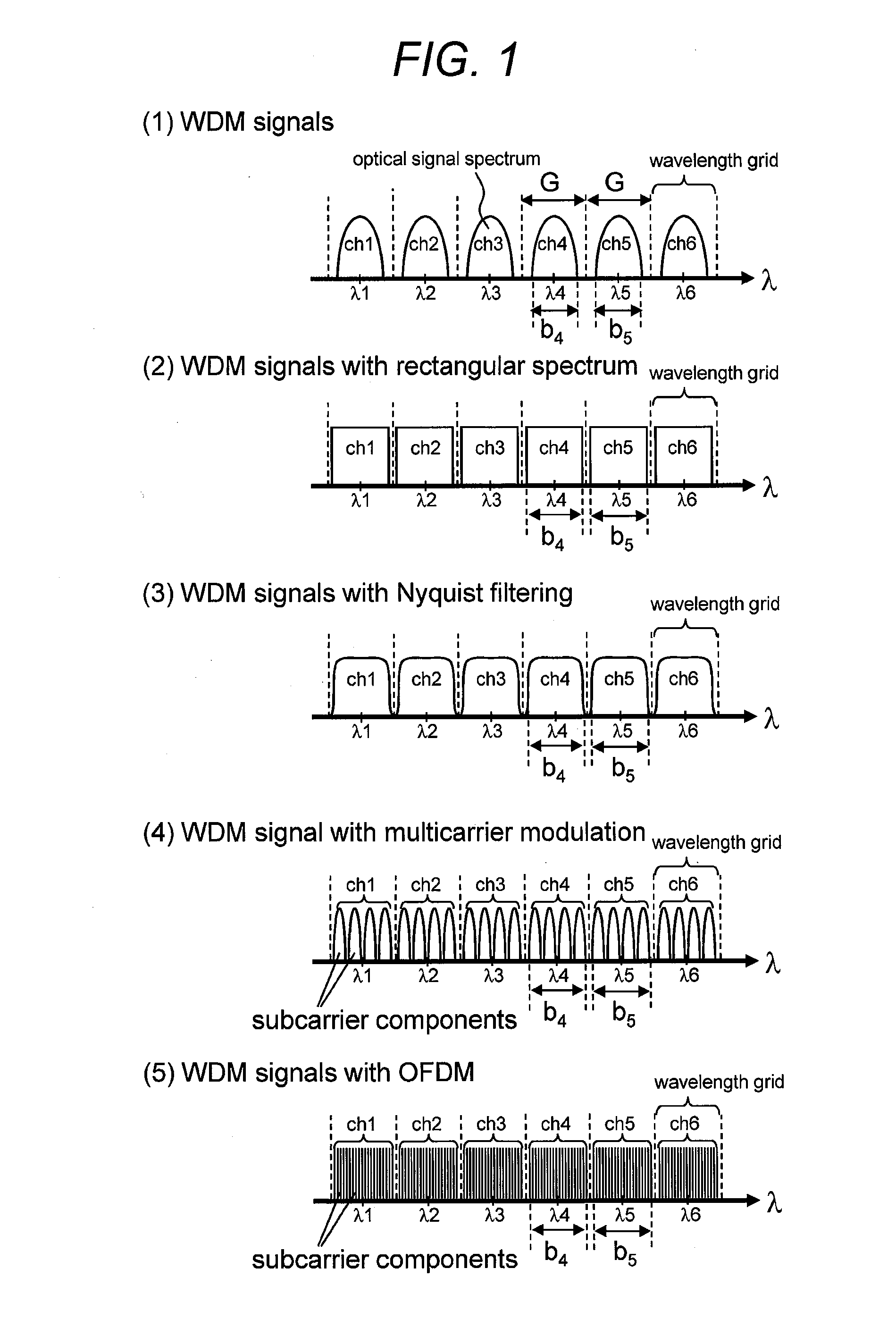Wavelength-multiplexed optical transmission device, wavelength-multiplexed optical transmission system, wavelength-multiplexed optical transmission method
a transmission device and optical transmission technology, applied in the field of wavelength selective switch, to achieve the effect of suppressing a signal spectrum defici
- Summary
- Abstract
- Description
- Claims
- Application Information
AI Technical Summary
Benefits of technology
Problems solved by technology
Method used
Image
Examples
first embodiment
Conclusion
[0067]As described above, the WSS node 100-1 according to the first embodiment is configured to cause flat portions of adjacent transmission bands on a wavelength spectrum to overlap. Further, the output WDM signal 104-1 includes the optical signal of the channel 4 and the residue of the channel 5 together, and the output WDM signal 104-2 includes the optical signal of the channel 5 and the residue of the channel 4 together. In other words, the WSS node 100-1 can not only extend a transmission band to include an adjacent channel but also output portions in which transmission bands overlap to respective output destinations at the same time. Thus, it is possible to switch high-density WDM signals without any deficit.
[0068]In the first embodiment, the DWDM is generated by multiplexing the optical signals of the channels 1 to 6 individually output from the high spectral density optical transmitters 107-1 to 6 by the optical coupler 115 having no wavelength selectivity. Further...
second embodiment
Conclusion
[0084]As described above, in the WSS node 100 according to the second embodiment, the WSS 110-1 outputs a transmission band at a short (or long) wavelength side, and the WSS 110-2 outputs a transmission band at a long (or short) wavelength side. As the WSS nodes alternately deal with the channels, it is possible to set wide transmission bands which overlap each other to the two output optical fiber lines at the same time and prevent a deficit of a signal spectrum as described in the first embodiment. The internal configuration of the WSS node 100 is an example for implementing the basic concept of the present invention, and does not deny implementation of the same function by any other configuration.
third embodiment
[0085]FIG. 9 is a configuration diagram illustrating a WSS node 100 according to a third embodiment of the present invention. The WSS node 100 according to the third embodiment has a 1:3 configuration of outputting an arbitrary optical signal to three output fiber lines 103-1, 103-2, and 103-3 using two WSSs 110-1 and 110-2.
[0086]The WSSs 110-1 and 110-2 are a WSS having a 1:3 configuration. Output ports of both switches are coupled by optical couplers 115-1, 115-2, and 115-3 by two, and then output to the three output optical fiber lines 103-1, 103-2, and 103-3. The optical signals of the channels 1 to 6 are input to the input optical fiber line 101, and the wavelength channels 2 and 6, 4 and 5, and 1 and 3 are output to the output optical fiber lines 103-1, 103-2, and 103-3.
[0087]FIG. 10 is a diagram illustrating a relation between an optical signal spectrum and a transmission band of the WSS node 100 according to the third embodiment. In the third embodiment, there are several me...
PUM
 Login to View More
Login to View More Abstract
Description
Claims
Application Information
 Login to View More
Login to View More - R&D
- Intellectual Property
- Life Sciences
- Materials
- Tech Scout
- Unparalleled Data Quality
- Higher Quality Content
- 60% Fewer Hallucinations
Browse by: Latest US Patents, China's latest patents, Technical Efficacy Thesaurus, Application Domain, Technology Topic, Popular Technical Reports.
© 2025 PatSnap. All rights reserved.Legal|Privacy policy|Modern Slavery Act Transparency Statement|Sitemap|About US| Contact US: help@patsnap.com



